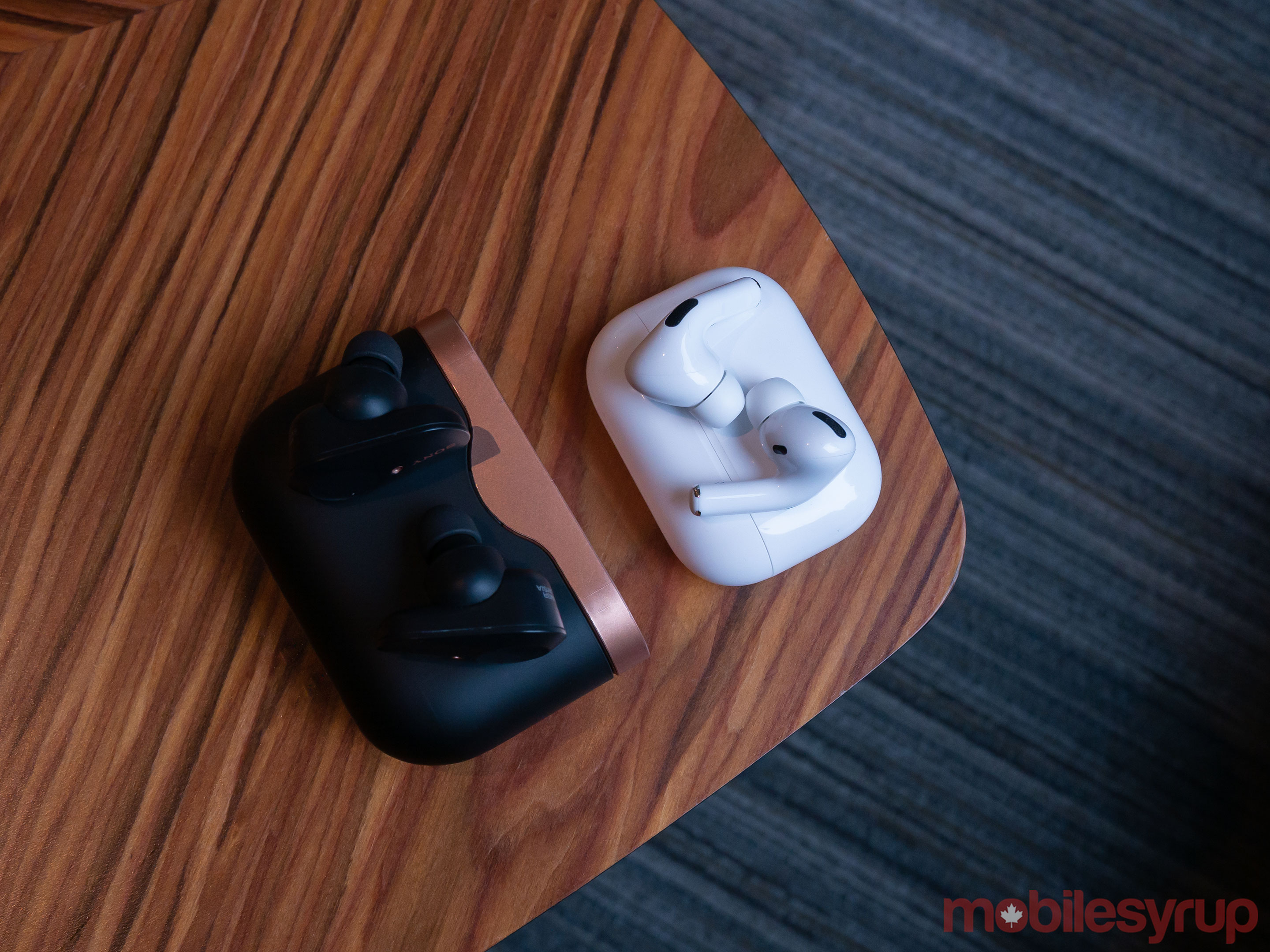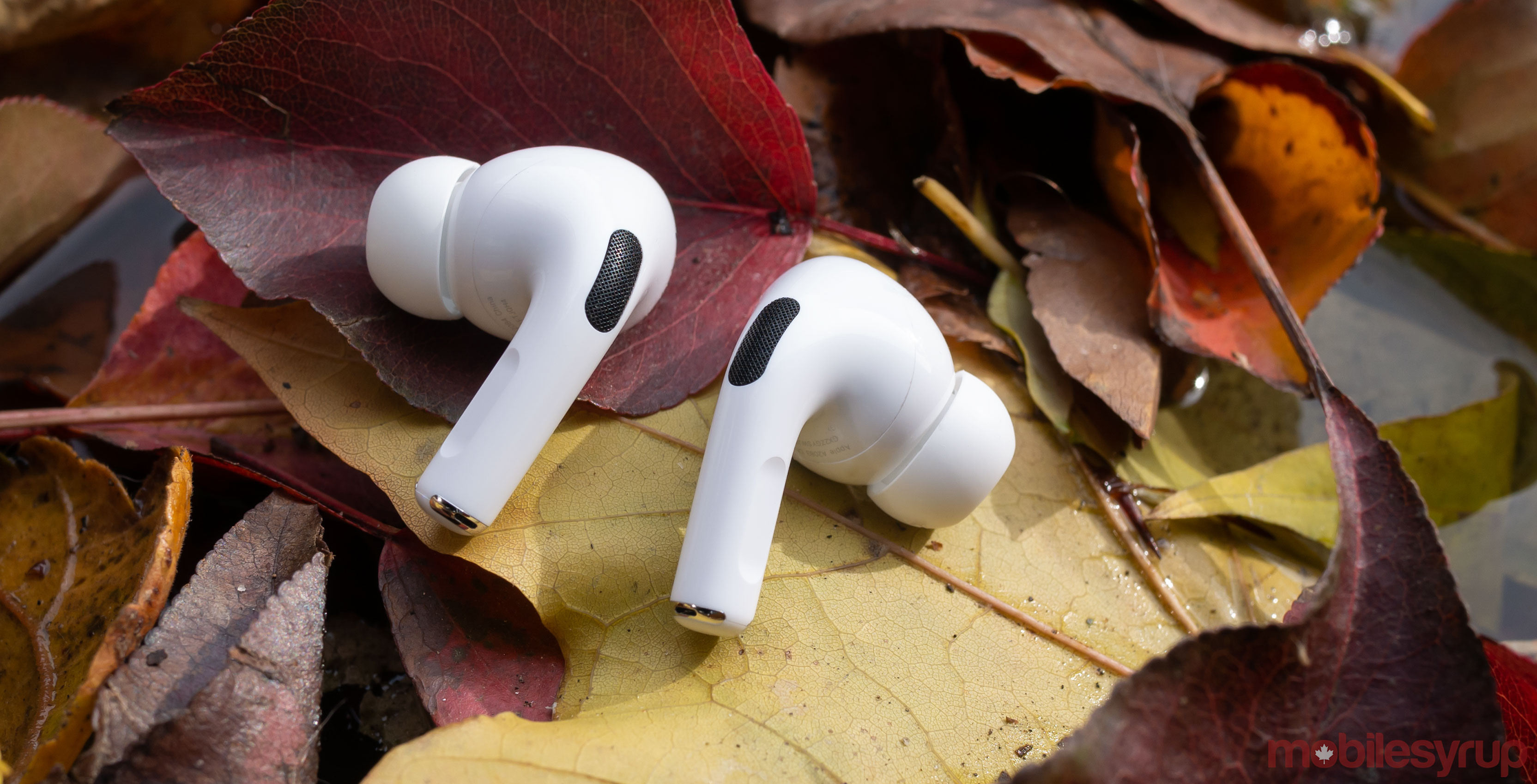
The Pros
- Noise-cancelling is excellent
- Sound quality is better than 2nd-gen AirPods
- Very comfortable
The Cons
- Battery life isn't great
- Expensive
- Physical controls are unreliable
What surprised me the most about Apple’s AirPods Pro is how comfortable the noise-cancelling headphones are in my ears.
I’ve tried several brands, but in-ear headphones have always felt like an insect burrowing into my ear canal. I’ve been told I’m not using the correct-sized tips despite having tried various sizes, or that the uncomfortable pressure sensation I experience is normal.
While I’ve spent time with in-ear earbuds like Samsung’s Galaxy Buds and Sony’s superb WF-1000XM3s, I’ve always found that I wasn’t able to keep either pair in my ears for long before they became unbearable.
Apple’s new AirPods Pro solve this issue. Even after wearing the new earbuds for roughly five hours straight, they remained comfortable.
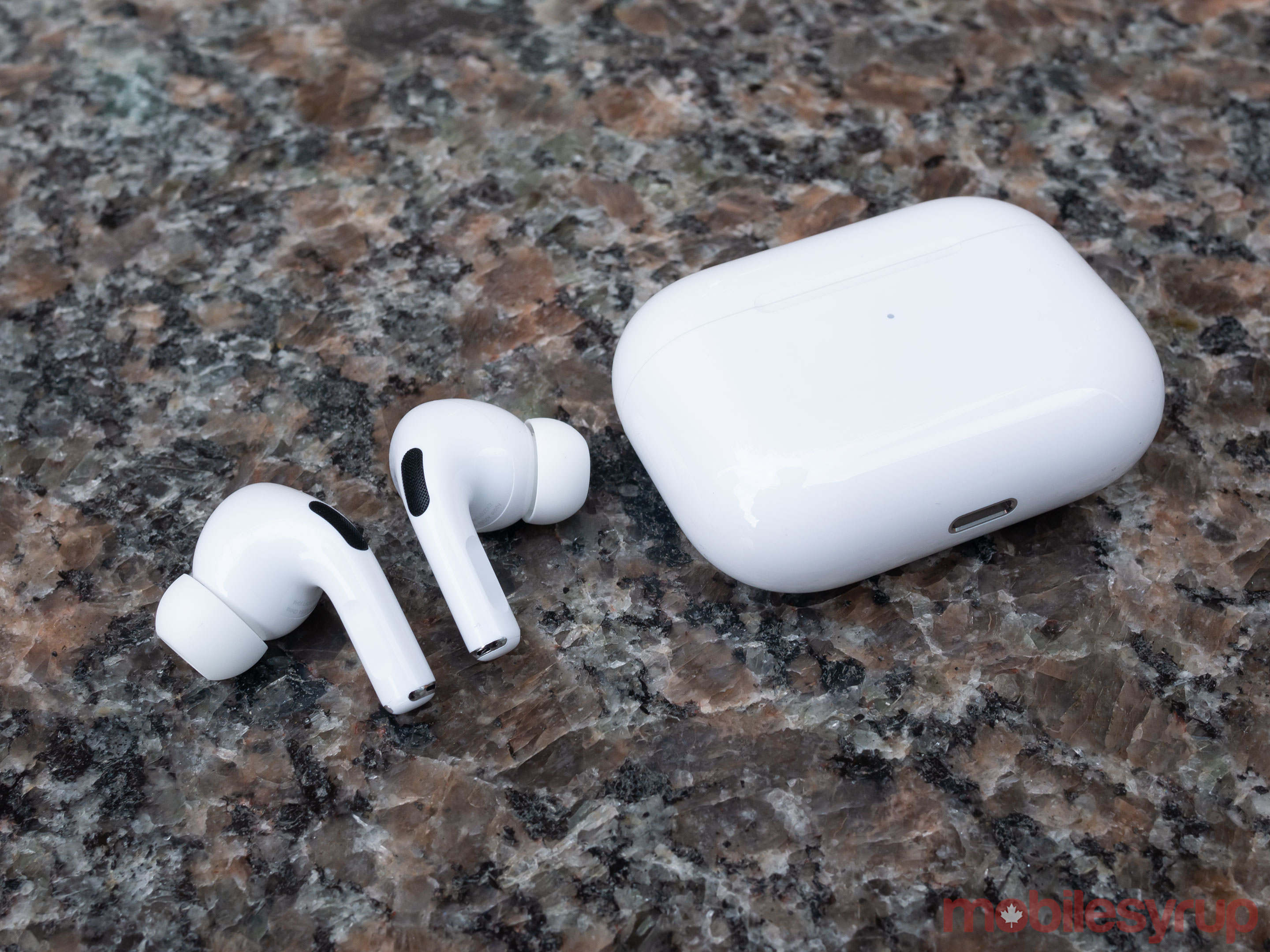
There are other improvements over the 2nd-generation AirPods as well, including impressive active noise-cancelling and better sound quality. Regardless of if I was listening to music and podcasts, or watching videos, Apple’s new premium earbuds always sounded crisp and featured a surprising amount of bass — especially for earbuds.
The AirPods Pro aren’t without issues, though. For one, they’re pricey, coming in at an expensive $329, and they don’t sound significantly better than competing wireless earbuds.
The main question surrounding Apple’s AirPods Pro is how they compare to the soon-to-be-released competition, including Microsoft’s upcoming Surface Buds, Google’s Pixel Buds and even Amazon’s Echo Buds.
It’s worth noting that while I expect all of the above wireless earbuds to launch here eventually, specific Canadian release dates have not yet been revealed for any of them.
Impressive active noise-cancelling
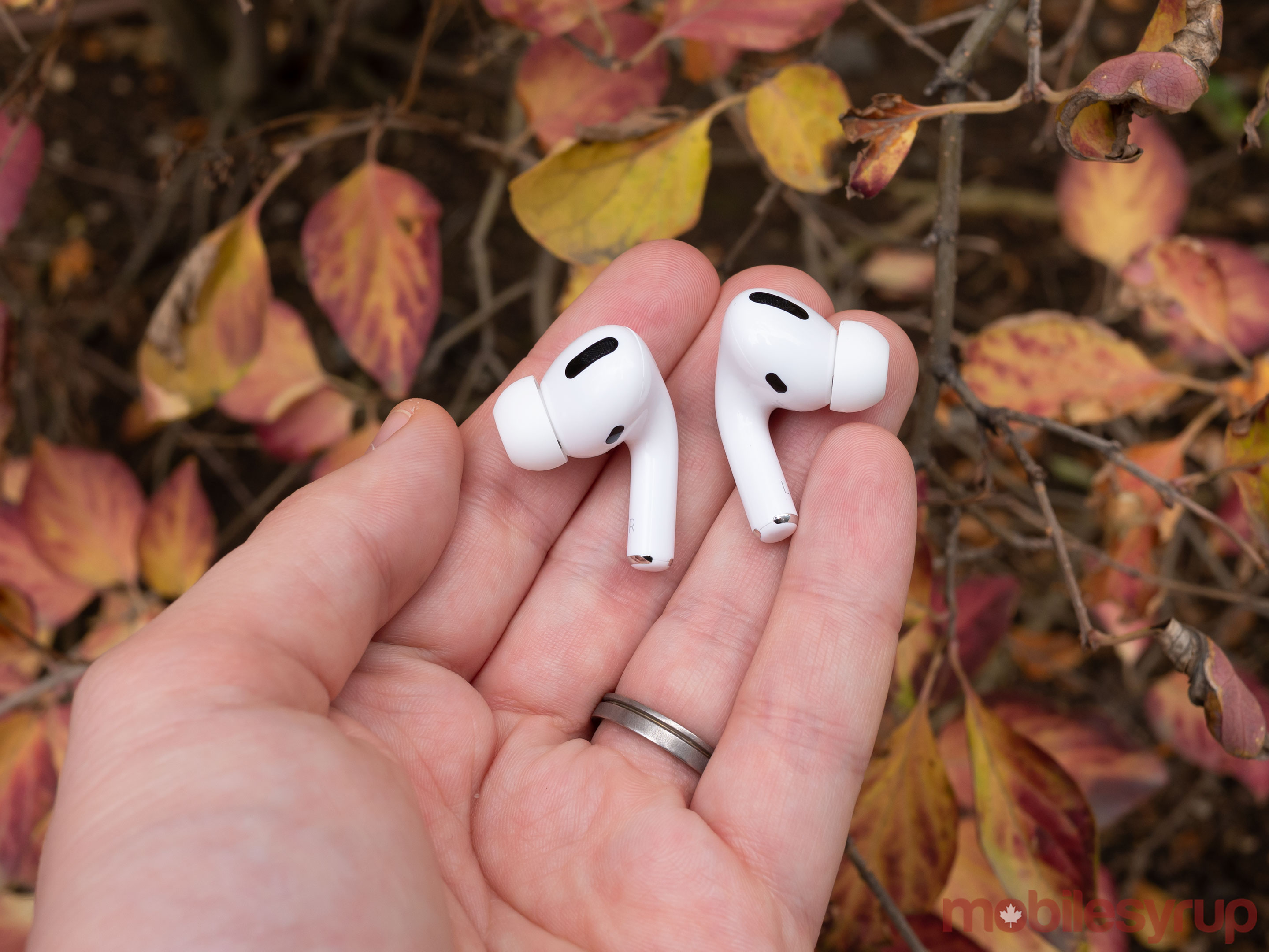
A critical factor to keep in mind with Apple’s AirPods Pro is the wireless earbuds’ active noise-cancelling.
Unlike standard noise-cancelling that attempts to block out unwanted sounds, the AirPods Pro are continually adapting to the specific environment around them. The earbuds feature an outward-facing microphone that detects surrounding sound to counter it with equal anti-noise.
An inward-facing microphone then listens to the inside of your ear, eliminating additional sound. This entire process occurs up to 200 times per second, according to Apple.
In practice, the results are more impressive than I expected. With a proper seal (more on this later), the outside world is nearly completely gone, with only crisp, clear audio remaining. This is in contrast to Apple’s standard AirPods or other wireless earbuds that don’t feature any form of noise-cancellation. If you’ve ever tried using AirPods or Samsung’s Galaxy Buds on an airplane, you’ll know what I’m talking about.
When directly comparing active noise-cancellation between the AirPods Pro and Sony’s WF-1000XM3s, I found both earbuds performed similarily, but I’d give the advantage to Apple’s AirPods. They adapt quickly to the noise around them and block out slightly more sound, especially when in a noisy environment like the MobileSyrup office. The difference is marginal, though.
That said, the quality of noise-cancelling with in-ear doesn’t compare to the way the feature works in over-ear headphones. The inherent nature of in-ear earbuds means at least some unwanted noise will get into the headphones. Apple-owned Beats’ new Solo Pro 3 over-ear headphones feature adaptive noise-cancelling that seems very similar to what the AirPods Pro offer, while Powerbeats Pro don’t include the feature at all.
“If you’ve ever tried using AirPods or Samsung’s Galaxy Buds on an airplane, you’ll know what I’m talking about”
The AirPods Pro block out a fair amount of noise though, which resulted in situations where I felt a little uncomfortable walking in downtown Toronto during rush hour. These situations are where ‘Transparency Mode’ comes into play. This sound pass-through feature utilizes the Pro’s microphones and a system of vents in the earbuds to pass sound from the outside world that would otherwise be blocked by the silicone tips.
I found myself using ‘Transparency Mode’ often when walking around outside so I was more aware of my surroundings.
Unparalleled comfort

Apple’s AirPods Pro are the only in-ear wireless Bluetooth earbuds I have ever used that don’t immediately feel uncomfortable.
There are a variety of factors at play that make this happen. First, rather than several tips, Apple has stuck to ‘Large,’ ‘Medium,’ and ‘Small’ tips. While both Small and Medium felt comfortable and offered an adequate seal, I ended up going with the latter option because it made the AirPods Pro sit more snugly in my ears when walking or running.
Apple says it used 3D ear scans from thousands of people to model the fit of the earbuds, allowing the company to know exactly where the AirPods Pro should and shouldn’t touch the wearer’s ears.
While this might sound like exaggerated marketing on Apple’s part, you can feel the attention to detail when you’re wearing the earbuds.
The tip extending down from the speaker has also been shortened with the AirPods Pro, making the earbuds fit more snugly and conform to the side of your ear. This is an issue I had with Sony’s WF-1000XM3 earbuds. Regardless of how I put them in my ears, they always felt bulky and awkward because they’re so large.
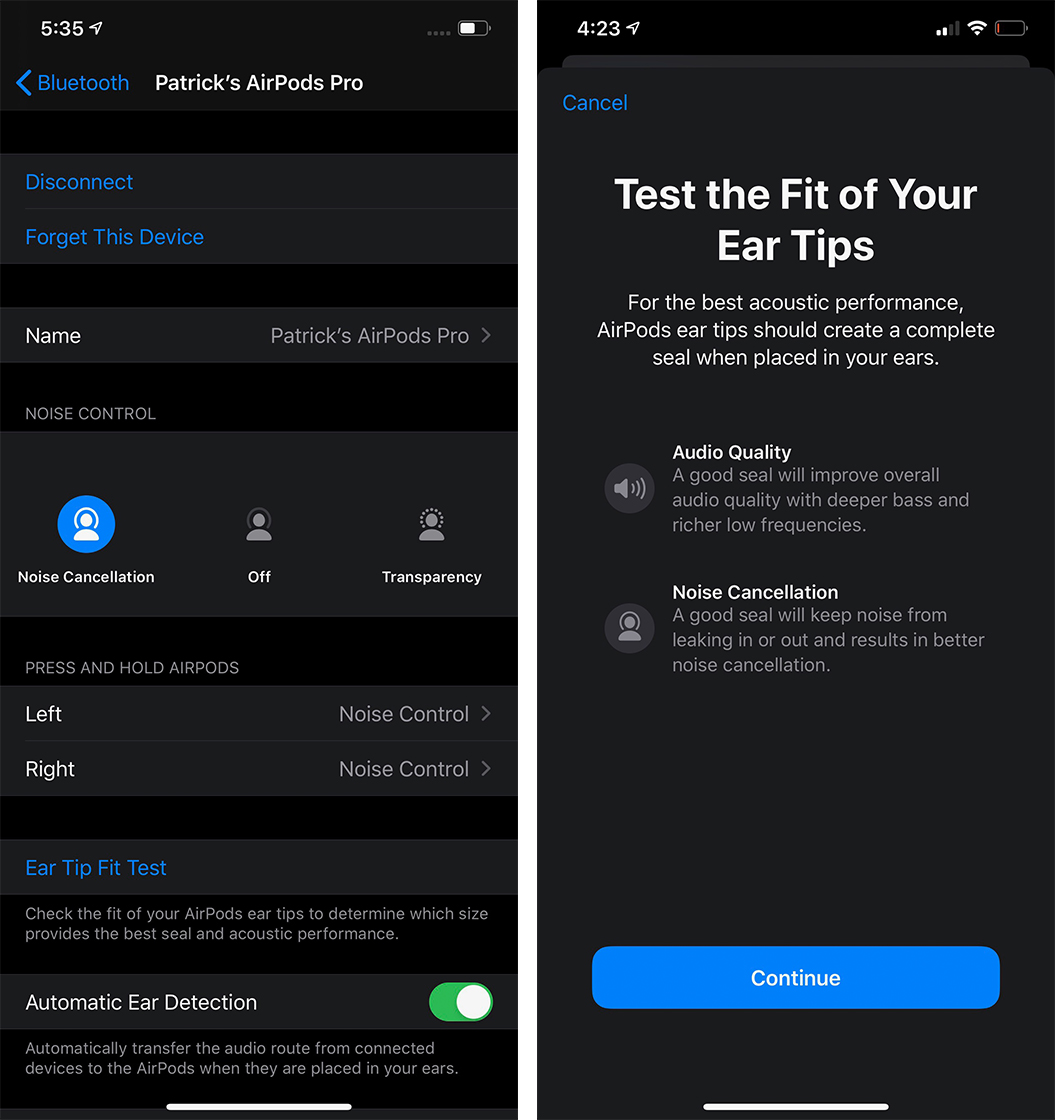
The AirPods Pro tips are unfortunately rather difficult to remove. The in-box instructions say to pull on the tip, and it’ll pop off. While true, you need to really tug at them. I found sliding my fingernail in the small slot located inside the tip, and then pulling up, made them pop off easier.
There’s also a useful feature accessed through the earbuds’ Bluetooth settings called ‘Ear Tip Fit Test’ that allows you to know for sure that you’re using the correct tips. While a short song plays, algorithms work with the inward-facing microphone in each AirPod to measure the tip seal.
While a minor feature, it’s nice to have that extra peace of mind knowing you’ve selected the best tips for your ear shape. That said, the test indicated that I could use either the small or medium tips, which didn’t exactly give me a definitive answer.
Another comfort feature I hope more manufacturers start including in wireless earbuds is the vent in the AirPods Pro that equalizes the pressure inside and outside the wearer’s ear. The sensation I often experience with other in-ear earbuds that feels like my ear is plugged isn’t something I’ve encountered with Apple’s new earbuds. This also makes it easier to wear the earbuds for longer periods of time.
Improved sound quality
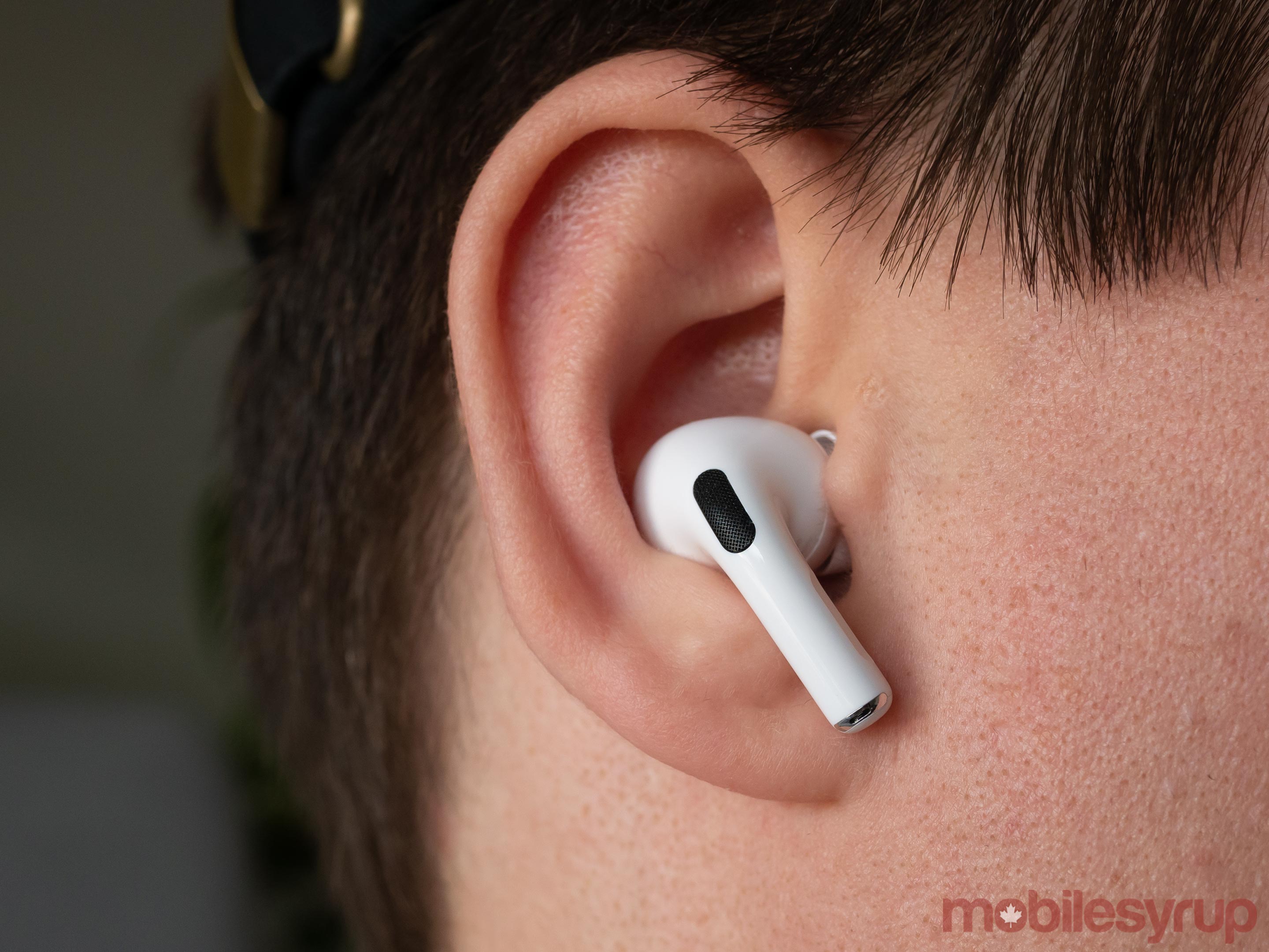
Similar to noise-cancelling, one crucial thing to keep in mind is that the sound quality you’re going to get from in-ear earbuds will never quite stand up to what over-ear headphones offer.
With that out of the way, it’s important to note that while Apple’s AirPods Pro are an improvement in sound quality over the 2nd-gen AirPods, some might not notice the difference, especially if you don’t have noise-cancelling enabled.
Whether I was listening to guitar-driven music like Selkirk, Manitoba-born Goody Grace’s ‘Scumbag (ft. Blink-182),’ Saves The Day’s recent reissue of ‘Through Being Cool’ or the Menzingers’ ‘America (You’re Freaking Me Out),’ mids and highs remained clear and featured notable dynamic range.
“…the difference in sound quality between Apple’s AirPods Pro and Sony’s WF-1000XM3 earbuds is negligible”
I’d even go so far as to say that I noticed vocals or guitar riffs I otherwise haven’t heard before in songs. On the other hand, more bass-driven tracks like Lil Peep’s ‘Belgium,’ 21 Savage’s ‘Immortal,’ or even something like Turnstile’s ‘Real Thing,’ feature the deepest bass I have ever experienced from a pair of earbuds.
When pitting the AirPods Pro directly against Sony’s WF-1000XM3 earbuds, I’d again give Apple’s earbuds the win. Sound quality is very similar, with the WF-1000XM3 sometimes handling the highs of a song better than Apple’s earbuds, but the impressive bass featured in the AirPods Pro overshadows this.
Again, though, similar to noise-cancellation, the difference in sound quality between Apple’s AirPods Pro and Sony’s WF-1000XM3 earbuds is negligible.
Control issues

One of my main issues with the AirPods Pro is how difficult they are to control. The same speech-detecting sensor and motion accelerometer found in the 2nd-gen AirPods is back. This means that the ‘Hey Siri’ commands work just as great as they did with the 2nd-gen AirPods. Further, the AirPods Pro know when they’re in your ears, just like the earbuds’ predecessors.
Physically controlling the headphones is a little different this time, unfortunately. There’s now a force sensor located in the tip of the left and right bud. To switch between active noise cancellation and Transparency Mode, you press and hold the stem. Tapping plays, pauses or answers a call, double-tapping skips forward and three-presses skips back.
While this all might sound simple, I found the touch controls to be unreliable. However, over the past few days, they slowly became more dependable as I built up my muscle memory. Unfortunately, the actual act of pressing the headphone stem is still nowhere near as consistent as just tapping the standard AirPods. To be fair, I also experienced similar issues with the WF-1000XM3s physical controls.
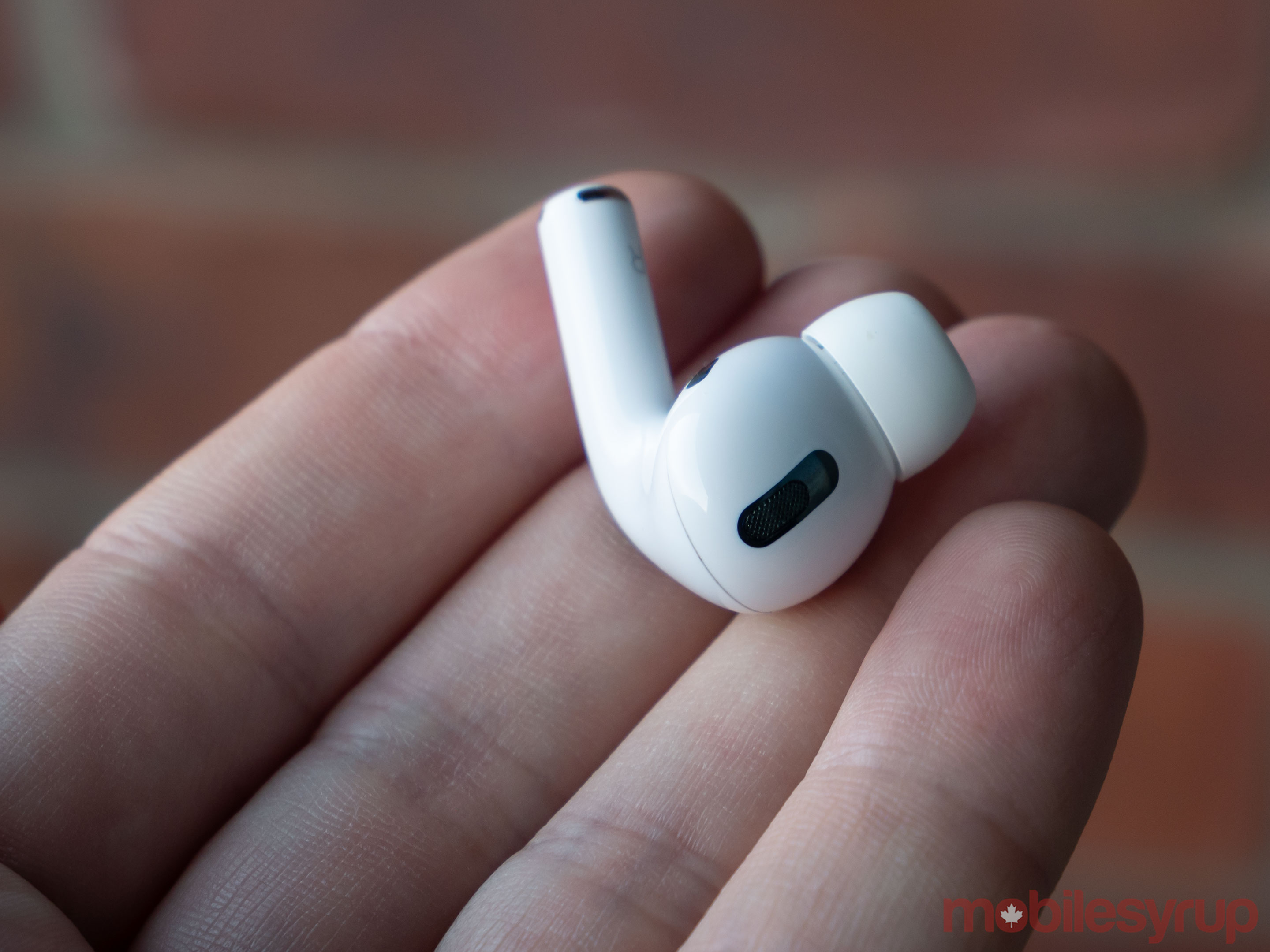
Call quality seems identical to the standard AirPods in my tests, which means that generally, Apple’s new earbuds are great for taking calls unless it happens to be windy outside.
To my horror, I’ve accidentally put both the 1st-gen and 2nd-gen AirPods through the washing machine (without their charging case) at least twice over the last few years. Thankfully they were fine, but with the AirPods Pro, Apple has added IPX4 sweat and water resistance to the wireless earbuds. Anyone who plans to use the AirPods Pro while exercising will appreciate this feature.
Everything else
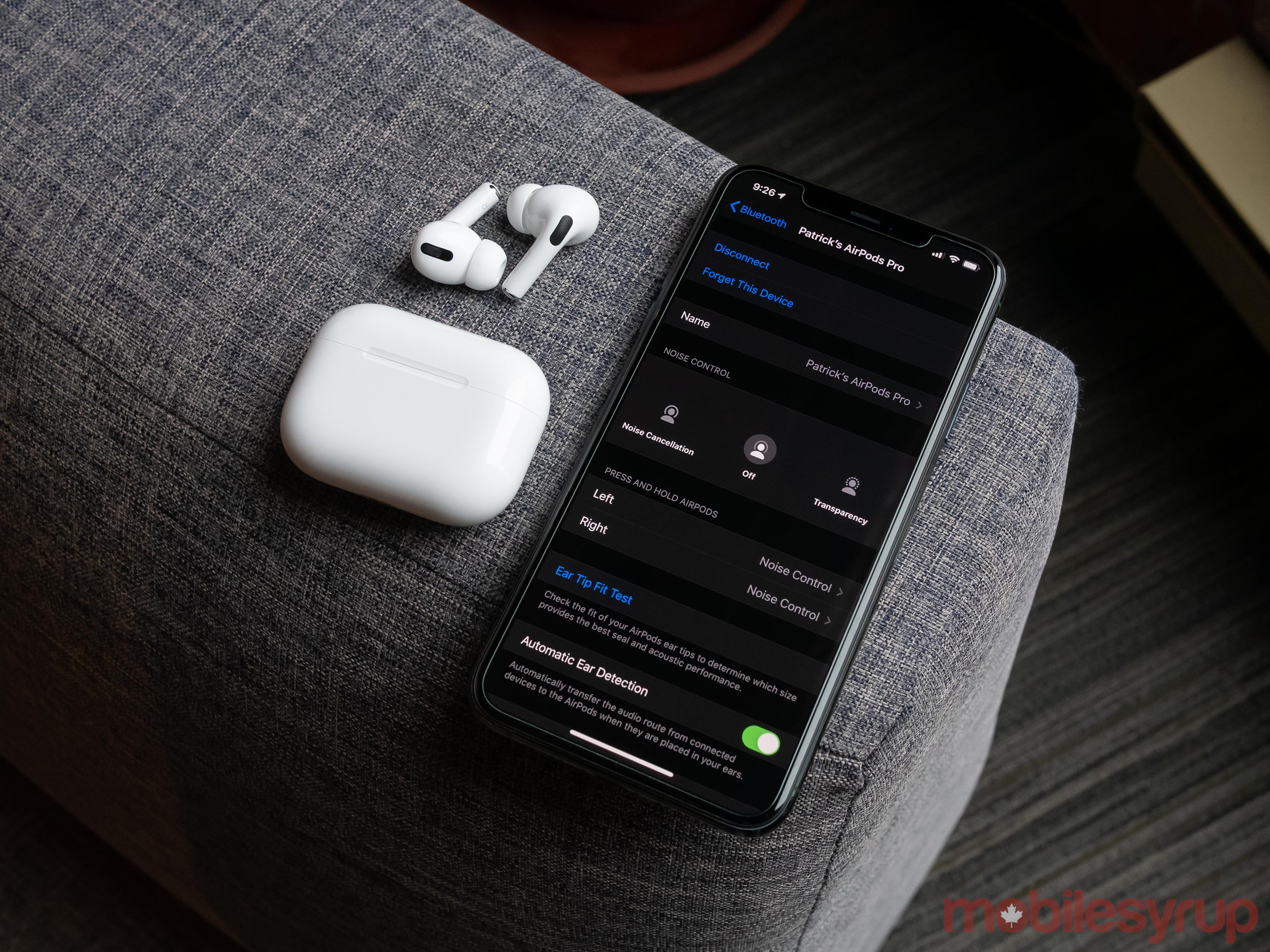
One of the main draws of Apple’s AirPods has always been their reliable Bluetooth connection, as well as how easily they connect to the iPhone. These features are back with Apple’s H1 chip, the same silicon featured in the 2nd-gen AirPods.
While the instant connecting experience is nearly identical to the 2nd-gen buds, I did find that the AirPods Pro feature a more reliable Bluetooth connection. With the 2nd-gen AirPods, sometimes when I’m walking around downtown Toronto, I’ve experienced bouts where music stutters or my connection briefly drops. In the little over a week I’ve been using the AirPods Pro, this hasn’t happened once.
Of course, this magic, is gone when you use the AirPods Pro with an Android device and, disappointingly, often even when connecting them to my MacBook Pro. Sometimes, the earbuds would automatically connect after being paired with my MacBook Pro, but this didn’t happen consistently. You’re then forced to navigate to your device’s Bluetooth settings to connect them manually. The feature that pauses audio when you remove the AirPods Pro from your ear is also gone when using the earbuds with Android devices.
This brings me to battery life, another drawback with the AirPods Pro. While the earbuds offer up to five hours of listening time with Active Noise Cancellation and Transparency Mode turned off, this defeats the purpose of owning the earbuds in the first place.
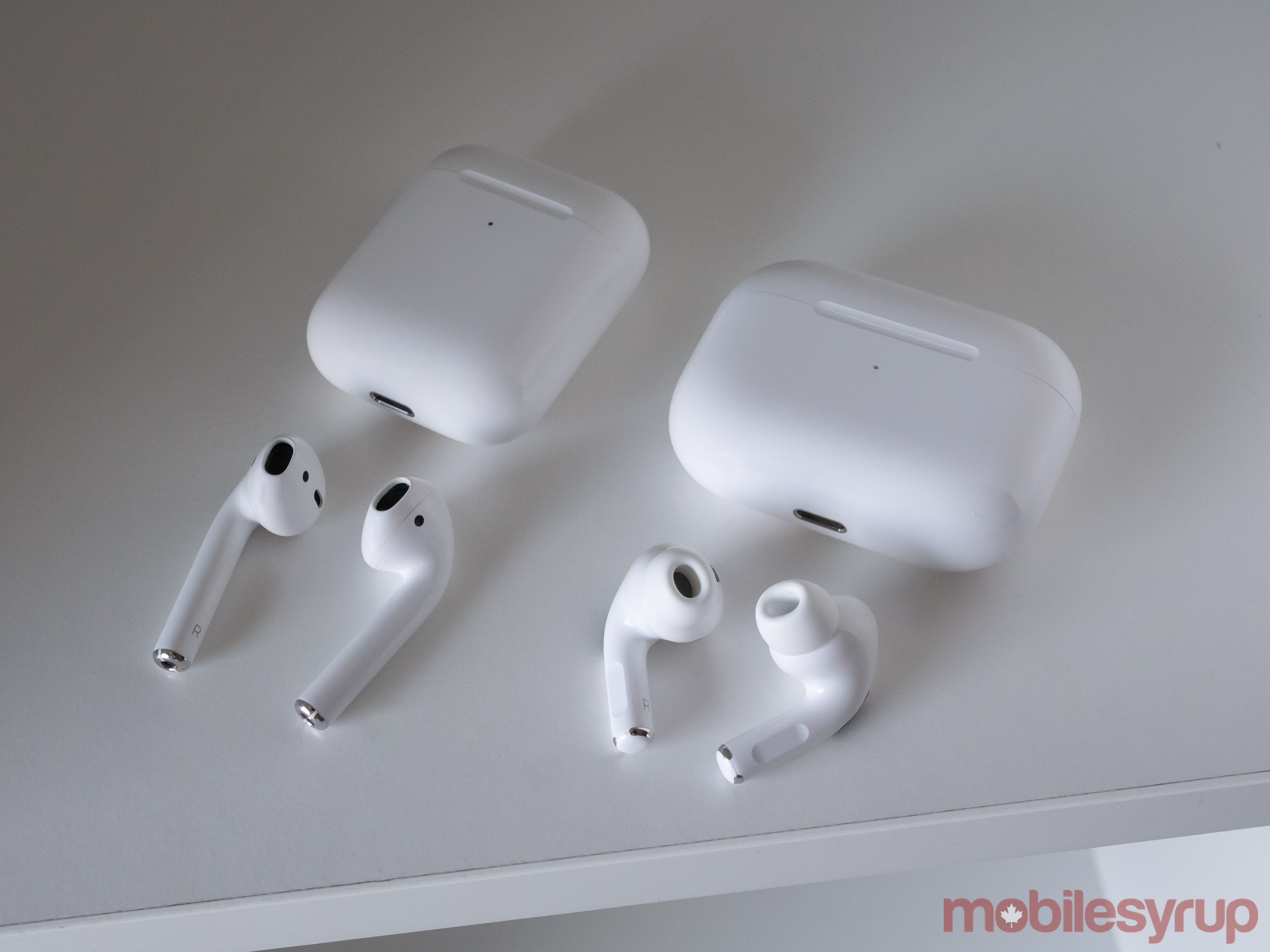
In my experience, the AirPods Pro typically last four hours, which is roughly the same as what the 2nd-gen version of Apple’s earbuds feature. Given the expensive price tag attached to the AirPods Pro, as well as the fact that the company is positioning them as premium earbuds and a significant upgrade over the 2nd-gen AirPods, I expected more of an improvement in battery life.
The Pro’s more stout charging case offers 24 hours of charging time, with a five-minute charge resulting in roughly an hour of battery life. The AirPods Pro charging case is identical to the 1st- and 2nd-gen AirPod case, only with a more rectangular shape. I did find it slightly more challenging to tell which slot each earbud needed to slide into, given the different shape of the AirPods Pro.
Other new AirPods Pro features have also arrived courtesy of iOS 13, including ‘Audio Sharing,’ which allows content to stream to two sets of AirPods connected to one device, and the ability to set Siri to announce Messages. Both of these features are also available with Apple’s other AirPods.
Is noise-cancelling vital to you?
At $329 CAD, Apple's AirPods Pro are undeniably pricey. Whether these wireless earbuds are worth it for you will depend on how much you value noise-cancelling in a pair of in-ear earbuds. It's also important to keep in mind that the earbuds' noise-cancelling, while impressive, doesn't compare to what similarily priced over-ear headphones offer.
Still, the AirPods Pro are the most comfortable, best-sounding wireless, Bluetooth earbuds I have ever used, surpassing even Sony's WF-1000XM3 earbuds by a slim margin in both noise-cancelling and sound quality.
If price isn't a concern for and you're looking for the best wireless earbuds out there right now, Apple's AirPods Pro might be perfect for you.
Similar to when the AirPods first launched though, the true test will be if they continue to hold this crown as Microsoft, Amazon and other companies release their upcoming wireless earbuds.
Apple's AirPods Pro are available in the Apple Store for $329"The AirPods Pro are the most comfortable, best-sounding wireless, Bluetooth earbuds I have ever used, surpassing even Sony's WF-1000XM3 earbuds by a slim margin in both noise-cancelling and sound quality"
MobileSyrup may earn a commission from purchases made via our links, which helps fund the journalism we provide free on our website. These links do not influence our editorial content. Support us here.

